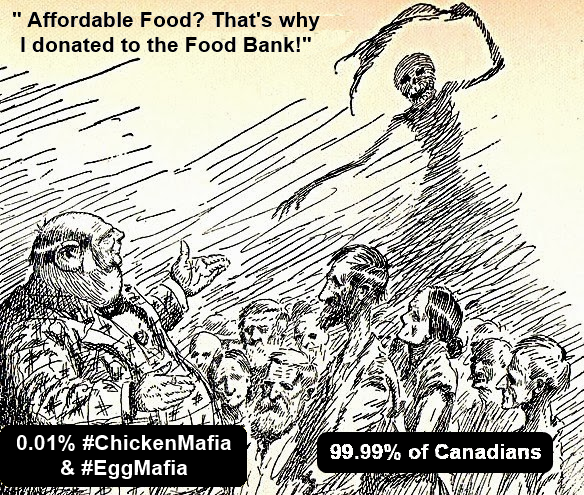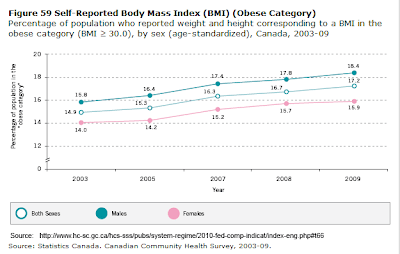I'm sure your region has similar scary news.
Health Canada has reported that 7.6% of Canadian families can't afford the food they need to feed their families (ie. "food insecurity"); as high as 28% in Nunavut (ie. the Far North of Canada).
What are the consequences of this food bank trend for Canadians?
I wanted to get some hard facts, rather than just my intuition.
I had done linear programming in Engineering at University some 35 years ago. I had used it time and again during my career to solve complex optimization problems.
I remember reading George Dantzig's historical review on the development of the Simplex method in the 1930's at the US Bureau of Labor Statistics, Urban Study of Consumer Purchases. The US Army needed to know what was the cheapest meal they could feed to soldiers in the field while ensuring they were adequately nourished ("The Diet Problem"). The rest, as they say, is history. The Simplex method of linear programming was born.
 |
| Solution for Diet Problem with between 0 to 300 grams of carbohydrate for a meal cost of US$0.956 |
The model uses a subset of foods and their nutrients from the USDA database here. Many of the foods used here are typical of N. American diets, and are one of the causes or contributing factors to our rising tide of disease (eg. obesity, diabetes, cardiovascular disease, high blood pressure, rheumatoid arthritis, stroke, dementia, etc.). I accepted and used this default subset database.
My intuition says, that when chicken and eggs are too expensive, people are forced to "dumb down" their food purchases, resulting in more and more carbohydrates in the shopping baskets. I therefore ran a number of simulations to see the impact of more or less carbohydrates in the permitted diet. A typical output is shown at the right. Click on it for a bigger version.
The lowest possible carbohydrate diet I could find that met the RDA (Recommended Daily Amounts) was 243 grams of carbohydrates, with the minimum cost being US $8.3288 per day. It is not clear when and where these default prices for the simulator database originate, but I assume the are a snapshot in time from somewhere in the USA, and are consistent within themselves.
 |
| Minimum cost of a nutritious meal vs. the maximum permitted carbohydrates. |
Any attempt to construct a lower carb. meal was impossible with the foods in this subset database. With the whole USDA database, I'm sure other alternative menus will become available. I leave that more comprehensive exercise to others, as I think what I have done here proves my intuition to be sufficiently accurate and useful..
I ran simulations from 243 gram/day, to as high as 10,000 grams of carbohydrate per day, seeking low cost meals. The resulting series of minimum meal prices is in the graph to the right.
The lowest carbohydrate level with the same or lower $/day cost was found at 312 grams of carbohydrate with a meal cost of $0.9303 per day. If you try to lower the carbohydrates below 312 grams, the meal cost goes exponentially higher in price from there on as you lower the carbohydrates.
Remember, this is US data, where chicken is 1/3 less expensive than in Canada, and eggs are 65.5% cheaper than in Canada. That means chickens and eggs are not affordable choices for Canadians, and we are pushed harder and sooner toward high carb., unhealthy meals.
It should be noted that Dr. Jay Wortman, a physician in British Columbia, has successfully maintained himself symptom-free (ie. diabetes Type II remission) by a ketogenic diet of 10 grams carbohydrate per day for more than 12 years. CBC TV did a documentary on his success, My Big Fat Diet. Fortunately, as a medical doctor, the higher scale income he enjoys allows him to better afford the gouging prices imposed by the #ChickenMafia and #EggMafia. For a quick summary, see a YouTube interview of Dr. Wortman here or watch it here:
By their monopolistic greed and uncaring actions, the #ChickenMafia and #EggMafia steal this cheap, effective, and healthy low carb. solution (ie. chicken and eggs) from most Canadians.
Meals with excessive carbs (ie. low carb is 10 to 60 grams of carb per day, the RDA is 130 g/day, while a typical North American diet has >300 g. carb. per day) usually cause or contribute to weight gain. Most people become more sedentary when consuming more carbs as a portion of their diet, causing a lower energy expenditure; compounding the weight gain effect. This high carb diet can partially explain the consistent increase in obesity in Canada, as reported by Health Canada.
The 243 g. carbohydrate daily intake menu at a cost of $8.3288 per day is as follows:
 |
| Optimum Meal Menu and servings for 243 g. of carbohydrate at a cost of US $8.3288 |
 |
| Optimum Meal Menu and servings for 306 g. of carbohydrates at a cost of US $0.9303 |
Which daily meal menu would you and your family prefer if you didn't have to pick up the cheque?
Note that the food prices go up by 895.3% if we try to drop the carbohydrate consumption by 25.9%.
Can Canadians and the world now see clearly why we have a huge problem? Canadians are forced, out of economic necessity, to eat more carbohydrates, rather that the astronomic prices we are charged for chicken and eggs.
Who will stand with Small Flockers to expose this crime against the Canadian people?
If you will not stand with us now, I suggest you lose the right to complain as hospital waiting rooms explode with sick people and taxes go through the roof to pay for all the sick people and the lost productivity.



No comments:
Post a Comment
Off-topic commercial spam that's posted so as to help sell your wares will be deleted.
On-topic comments, where you behave yourself and play nicely, will remain posted; whether they are pro or con. Everybody needs to fully understand all points of view so that we can find a solution that encompasses everybody's concerns. Give it your best shot.
If you decide to post, your posting becomes part of the public record, and SFPFC has full rights to use it (or not) in any reasonable manner or medium that suits our purposes.
Before posting, please proofread, and correct as necessary. If you subsequently discover a need to fix your previous posting, make an additional posting that refers to the original posting, then set the record straight.